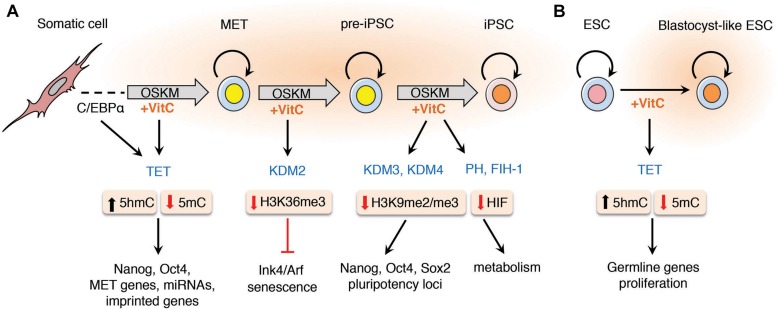FIGURE 1.
Vitamin C promotes somatic cell reprogramming by enhancing the activity of α-KGDDs. The addition of vitamin C to the culture medium of somatic cells during reprogramming enhances the activity of α-ketoglutarate dependent dioxygenases (α-KGDDs) including Jumonji-C domain-containing histone demethylases (JHDMs/KDMs), ten-eleven translocation (TET) proteins, prolyl hydroxylases (PH) and the asparaginyl hydroxylase FIH-1. (A) During somatic cell reprogramming it has been shown that transient C/EBPα expression up-regulates Tet2 expression that primes cells for mesenchymal-to-epithelial transition (MET). MET is an essential step required for the initiation of reprogramming that is dependent on TET-mediated DNA hydroxylation and demethylation of the enhancers and promoters of pluripotency genes (e.g., Nanog and Oct4) and for the expression of MET genes, miRNAs and to prevent hypermethylation and silencing of imprinted loci. The hypomethylation of histones by JHDMs such as KDM2 targets H3K36me3 for demethylation that suppresses the expression of senescence-inducing factors Ink4/Arf. Vitamin C also increases loss of H3K9me2/me3 by enhancing KDM3/4 activity to maintain expression at pluripotency loci during the final stages of reprogramming pre-iPSCs in to fully pluripotent iPSCs. Vitamin C may also reduce oxidative stress and increase the activity of hypoxia-inducible factor (HIF) prolyl hydroxylases and FIH-1 that promote the degradation of HIF that has also been shown to be important in the final stage of reprogramming. (B) Vitamin C treatment increases the proliferation of embryonic stem cells (ESCs) in culture and promotes demethylation of germline genes by enhancing TET activity to replicate the naïve “ground-state” of blastocyst-derived ESCs.

